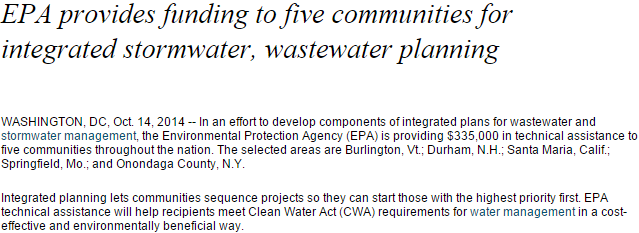The Environmental Protection Agency (EPA) regularly offers technical assistance grants (TAGs) to select communities as assistance in dealing with hazardous waste management. Communities hiring independent technical advisors for the same reason can obtain up to $50,000 in grants plus additional funding. To qualify for TAGs, however, a community must be located at a Superfund site.
Recently, five Superfund communities received a total of $335,000 in TAGs: Burlington, VT; Santa Maria, CA; Onondaga County, NY; Springfield, MO; and Durham, NH. These communities expressed their desire to develop integrated wastewater and storm water management systems that comply with the Clean Water Act.

Superfund stemmed from the Comprehensive Environmental Response, Compensation and Liability Act (CERCLA) of 1980, primarily in response to the discovery of toxic waste sites in the U.S. One such site is Love Canal in Niagara Falls, NY, which was used as a chemical dumpsite. Record rainfall burst the canal open, pouring toxic debris into the adjacent neighborhood.
One of the worst environmental disasters in American history triggered a nationwide search for other similar sites. The National Priorities List (NPL) documents more than 1,300 Superfund sites, of which 29 percent have been stricken from the list due to appropriate action having been taken. Burlington, VT’s toxic problem has persisted since it was first reported in 1998.
A Step in the Right Direction
TAGs may not be designed to fund modern stormwater BMPs, but at least the community is moving forward. Technical assistance, after all, is among the first steps toward implementing a stormwater management system. Such a task involves reviewing documents, surveying possible sites, interpreting information, and so on.
Once the blueprints are ready, the construction can begin. Among the most popular means of storm water management are rain barrels, like the StormChamber system. Crafted from high-density polyethylene, these rain barrels can hold storm water runoff and filter them at the same time with their trademark SedimenTrap™ containment system.
Rain barrels don’t have moving parts, which offers a cost advantage. Filtration happens by harnessing the tendency of dirt and other particles to settle out of solution, a process called sedimentation. Many academic institutions have touted StormChamber’s ability to remove large swathes of contaminants and make the runoff reusable for residential and commercial applications.
While a top-quality stormwater BMP may come at a cost, the long-term benefits are worth the installation cost. Contaminated storm water, after all, can threaten the welfare of countless residents. With efficient storm water containment and filtration solutions, more people can look forward to a greener America.
(Source: “EPA provides funding to five communities for integrated stormwater, wastewater planning,” WaterWorld, October 14, 2014)





